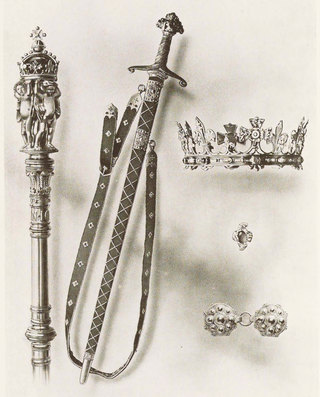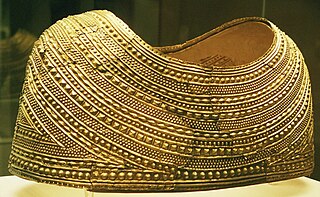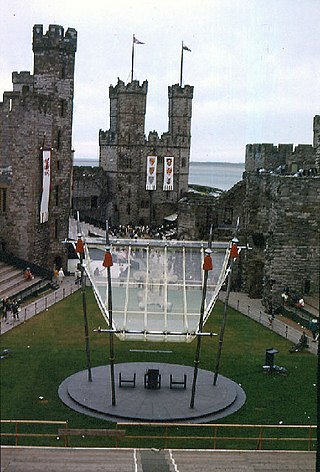
Prince of Wales is a title traditionally given to the male heir apparent to the English, and later British, throne. The title originated with the Welsh rulers of Gwynedd who, from the late 12th century, used it to assert their supremacy over the other Welsh rulers. However, to mark the finalisation of his conquest of Wales, in 1301, Edward I of England invested his son Edward of Caernarfon with the title, thereby beginning the tradition of giving the title to the heir apparent when he was the monarch's son or grandson. The title was later claimed by the leader of a Welsh rebellion, Owain Glyndŵr, from 1400 until 1415.

Caernarfon is a royal town, community and port in Gwynedd, Wales. It has a population of 9,852. It lies along the A487 road, on the eastern shore of the Menai Strait, opposite the island of Anglesey. The city of Bangor is 8.6 miles (13.8 km) to the north-east, while Snowdonia (Eryri) fringes Caernarfon to the east and south-east.

The Crown Jewels of the United Kingdom, originally the Crown Jewels of England, are a collection of royal ceremonial objects kept in the Jewel House at the Tower of London, which include the coronation regalia and vestments worn by British monarchs.

The Honours of the Principality of Wales are the regalia used at the investiture of the Prince of Wales, as heir apparent to the British throne, made up of a coronet, a ring, a rod, a sword, a girdle and a mantle. All but the coronet date from the investiture of Prince Edward in 1911 when most of the Honours of Wales were redesigned.
Carnarvon and Caernarvon are forms of the name Caernarfon which are no longer used for the town in north Wales, but remain in use in other contexts. The first two forms are in English orthography and the third is the Welsh spelling, adopted in English since the 1970s. Most places and things named after Caernarfon use one of the former spellings.

Welsh gold is gold found in natural geological deposits in two distinct areas of Wales and highly prized because of its origin and scarcity.

The regalia of Norway are items that symbolise the Norwegian monarch's power and majesty. Little is known of the old Norwegian regalia which have since been lost. The majority of the modern regalia date from 1818 and were made for the coronation of Jean Bernadotte as King Carl III Johan.

The Coronet of Charles, Prince of Wales is a small crown that is part of the Honours of Wales. The gold coronet, with diamonds set in platinum, was made for and used by King Charles III at his investiture as Prince of Wales in 1969. Designed by the artist Louis Osman, the coronet was a gift from the Worshipful Company of Goldsmiths to the Prince's mother, Queen Elizabeth II. It has been described as modern but its form is traditional. The coronet is on permanent display in the Jewel House at the Tower of London.

Llywelyn's coronet is a lost treasure of Welsh history. It is recorded that Llywelyn ap Gruffudd, Prince of Wales and Lord of Aberffraw had deposited this crown and other items with the monks at Cymer Abbey for safekeeping at the start of his final campaign in 1282. He was killed later that year. It was seized alongside other holy artefacts in 1284 from the ruins of the defeated Kingdom of Gwynedd. Thereafter it was taken to London and presented at the shrine of Edward the Confessor in Westminster Abbey by King Edward I of England as a token of the complete annihilation of the independent Welsh state.

Robert of Rhuddlan was a Norman adventurer who became lord of much of north-east Wales and for a period lord of all North Wales.
Welsh republicanism or republicanism in Wales is the political ideology that advocates for Wales to be governed by a republican system, as opposed to the monarchy of the United Kingdom.

Christopher David Williams was a Welsh artist.
This article is about the particular significance of the year 1820 to Wales and its people.

Joseph Morewood Staniforth was a Welsh editorial cartoonist best known for his work in the Western Mail, Evening Express and Sunday weekly the News of the World. Staniforth has been described as "...the most important visual commentator on Welsh affairs ever to work in the country."

The Prince of Wales is sometimes presented and invested with the insignia of his rank and dignity in the manner of a coronation. The title is usually given to the heir apparent of the English or British throne. An investiture is ceremonial, as the title is formally conferred via letters patent issued by the monarch.

Caernarfon Castle is a medieval fortress in Gwynedd, north-west Wales. The first fortification on the site was a motte-and-bailey castle built in the late 11th century, which King Edward I of England began to replace with the current stone structure in 1283. The castle and town established by Edward acted as the administrative centre of north Wales, and as a result the defences were built on a grand scale. There was a deliberate link with Caernarfon's Roman past—nearby is the Roman fort of Segontium—and the castle's walls are reminiscent of the Walls of Constantinople.

Coronations were previously held in the monarchies of Europe. The United Kingdom is the only monarchy in Europe that still practises coronation. Other European monarchies have either replaced coronations with simpler ceremonies to mark an accession or have never practised coronations. Most monarchies today only require a simple oath to be taken in the presence of the country's legislature.

The coronation of George VI and his wife, Elizabeth, as king and queen of the United Kingdom and the Dominions of the British Commonwealth, Emperor and Empress consort of India took place at Westminster Abbey, London, on Wednesday 12 May 1937. George VI ascended the throne upon the abdication of his brother, Edward VIII, on 11 December 1936, three days before his 41st birthday. Edward's coronation had been planned for 12 May and it was decided to continue with his brother and sister-in-law's coronation on the same date.
The 1969 Investiture Honours were appointments made by Queen Elizabeth II of the United Kingdom to various orders and honours released on 7 July 1969, on the occasion of the investiture of her eldest son, Charles, as Prince of Wales. The awards were of a special character compared to most honours lists, in that the awardees were selected due to their links with Wales, or involvement with the investiture ceremony itself.

The investiture of Charles, Prince of Wales, took place in Caernarfon Castle, north Wales, on 1 July 1969. The ceremony formally presented the title of Prince of Wales to the 20-year-old Charles, eldest son of Queen Elizabeth II. He was the 21st heir to the English or British throne to hold the title. The investiture was a revival of a ceremony which had first been used for the previous prince of Wales, Edward, in 1911. The 1969 event was watched by 500 million people worldwide on television, but it received some opposition in particular from Welsh nationalist organisations.


















